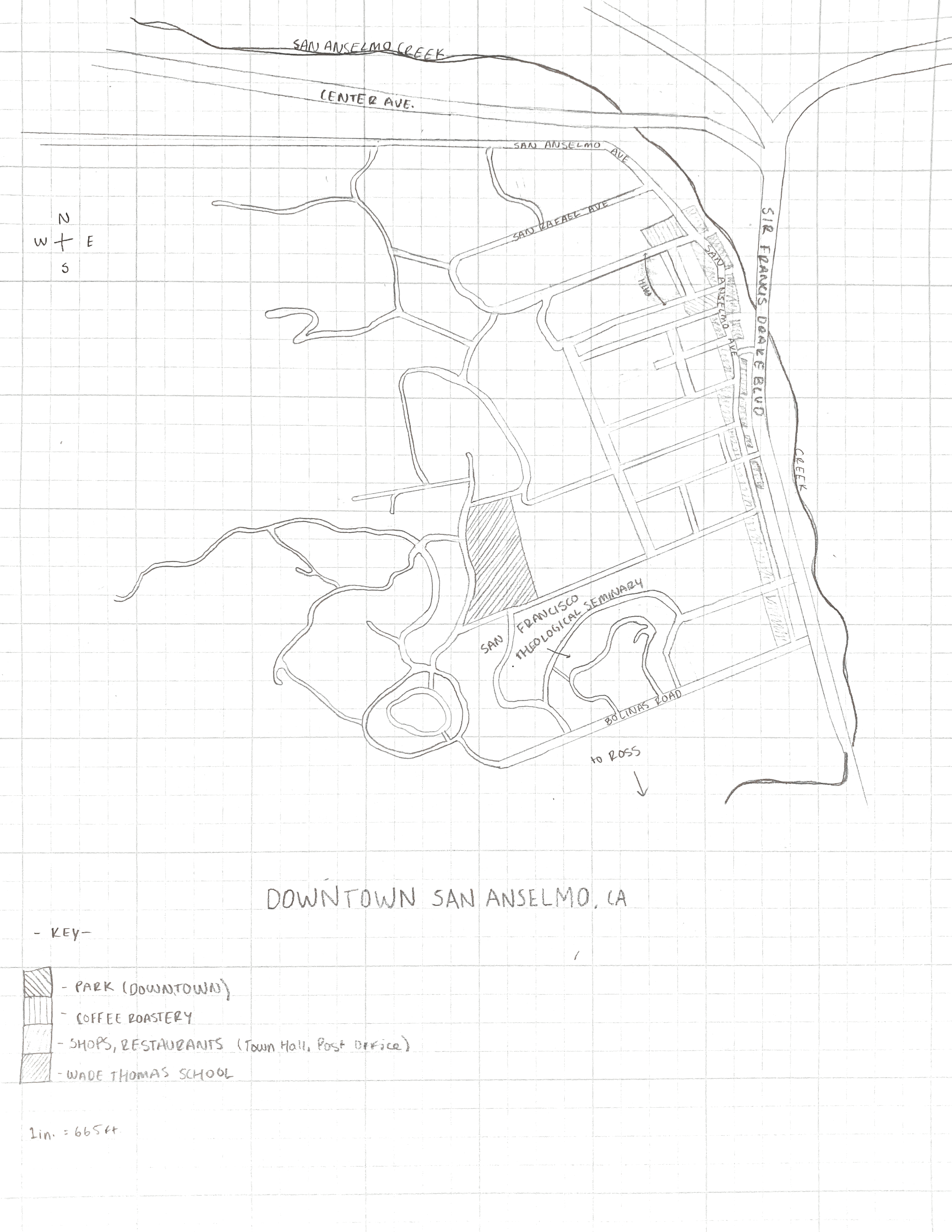Downtown San Anselmo
The San Anselmo Coffee Roastery, on the corner of San Anselmo Avenue and Tamalpais Avenue, lies firmly in downtown San Anselmo. Despite the Roastery’s proximity to two edges, any resident of the town would assert the coffee shop is downtown, and the view from the intersection it proceeds over is, in fact, one of the town’s few landmarks. The “main street” layout of the town places the Roastery on a rare intersection of two paths. Additionally, the neighborhood it occupies is in keeping with Perry’s analysis of a well-arranged neighborhood.
Downtown San Anselmo is bound by four distinct edges, as defined by Kevin Lynch. A block north of Tamalpais Avenue, San Rafael Avenue should be considered the top edge of downtown. The neighborhood to the north of the avenue is commonly described as “almost downtown” and the avenue is the last to complete a grid pattern. To the east of San Anselmo Ave., Sir Francis Drake Boulevard, the thoroughfare that carries traffic from the freeway to the Pacific Ocean, splits most of San Anselmo from the official eastern boundary of town. Center Ave., built over railroad tracks, intersects Drake and continues the edge further west. To the south, Bolinas Road provides no physical barrier, but the town line runs down the middle, splitting San Anselmo from exclusive, insular Ross. To the west of the Coffee Roastery, the neighborhood ends as cross-streets run into mountainous open space. Although the Coffee Roastery occupies a corner located a block from both Center Ave. and San Rafael Ave., it is considered a part of downtown by the dozens of friends, family, and acquaintances I have spoken to about its location, likely because of these defined edges.
San Anselmo has very few landmarks within the downtown area, and the town is easily navigated by referring to surrounding hills and a central park. From the intersection observed from the outdoor seating at Coffee Roastery, Red Hill’s distinctive rusty hue and shape marks the beginning of the downtown’s main street, San Anselmo Avenue. At the other end of town, the buildings near the southern Ross-San Anselmo border give way to a view of the San Francisco Theological Seminary perched on a knoll, a view recognizable only at the end of town. These two landmarks represent the distant, stationary variety of landmarks Lynch describes. Along San Anselmo Ave., a park commissioned by San Anselmo resident George Lucas constitutes the one landmark in town. Residents often cite the park when they direct those unfamiliar with the town to new shops or destinations and Nextdoor discussions reference locations by describing their proximity to the park. Although there are few landmarks in town, the three define a start, center, and end of the neighborhood and serve to orient visitors with ease.
The Coffee Roastery lies along the two common paths through town, well-situated on a corner with heavy pedestrian traffic. The first route, unsurprisingly, runs along San Anselmo Ave., funneling pedestrians along the sidewalks bordered by shops and restaurants. Most pedestrians arriving to town on foot walk along this route. Some drivers park on the avenue or along a side street, and then walk along the avenue. The most engaging parts of downtown are strung along the avenue, and this path’s usefulness is evident. However, a partial “shortcut” path (that is, in fact, the same length as the avenue route) has emerged with the popularity of electric vehicles. In a parking lot located behind avenue-facing storefronts, the Town installed car chargers that allow the driver to park for free in the otherwise paid lot. As use increased, more people became aware of this alley and now pedestrians cut along this route, turning down Tamalpais Avenue and strolling by the Coffee Roastery to access San Anselmo Ave. In this way, San Anselmo’s two common paths lead directly to the Roastery, but also connect the town in two efficient, different ways.
San Anselmo, while lacking the nodes and districts Lynch describes, also resembles Perry’s description of a good neighborhood. The downtown neighborhood consists of a residential area located to the west of San Anselmo Ave., and maintains clear boundaries (discussed previously, in Lynch’s terminology, as edges). There are parks and open space; a park and two open spaces serve as the town’s landmarks. Local shops line San Anselmo Avenue, and provide amenities for the neighborhood’s residents, while Wade Thomas School located west of the avenue educates the town’s children through fifth grade. As mentioned in the earlier discussion of paths, there are clear routes through the town, supported by a clear grid that directs a light traffic flow through the town. The town lacks certain institutions Perry describes, but nonetheless fulfills his proposed criteria for a proper neighborhood.
Whyte explains a “good space beckons people in” (595) which the Coffee Roastery’s patio, located at the intersection of two popular paths, certainly does. Its patio also orients patrons towards one of San Anselmo’s three landmarks, and sits within a well-defined neighborhood, close to two of its edges but never excluded. Finally, the Roastery sits in downtown San Anselmo, a well-planned neighborhood by Perry’s standards, with issues nonetheless to be later explored.

